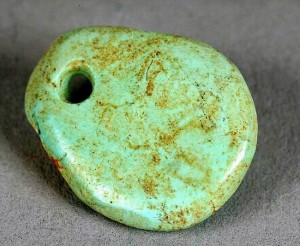 Turquoise is a blue to gray-green mineral consisting of copper aluminum phosphate. The mineral is a hyrous phosphate of aluminum, which includes a small percent of copper. The copper is what gives the mineral its blue coloring. When the turquoise mineral is associated with iron, that’s when you get the greenish turquoise. If the mineral contains zinc, the turquoise mineral will be a yellowish color.
Turquoise is a blue to gray-green mineral consisting of copper aluminum phosphate. The mineral is a hyrous phosphate of aluminum, which includes a small percent of copper. The copper is what gives the mineral its blue coloring. When the turquoise mineral is associated with iron, that’s when you get the greenish turquoise. If the mineral contains zinc, the turquoise mineral will be a yellowish color.
The mineral turquoise is formed by a chemical reaction which occurs when water containing specific minerals such as copper and aluminum leak through a rock. It forms in veins, which later then turn into a clump of turquoise.
Turquoise deposits are found in Arizona, Colorado, New Mexico, California, Nevada, Virginia, and Utah. The turquoise mineral is considered one of the highest value minerals in the world by most collectors. American turquoise is valued by its matrix pattern, color, hardness, and by origin. The most valuable turquoise always came from Iran, but the turquoise made in southwest is now known as one of the most valuable in the world.
The Anasazi, in the Southwestern part of the United States had opened their turquoise mine by 1000 AD. The mining locations in the Southwestern part of the United States included Arizona, Colorado, and New Mexico.
A turquoise history fact that most people don’t know, it’s the turquoise gem stone has been believed to be a holy stone, and used for getting rid of negative energy. The brightness of the color is supposed to be the symbol for happiness, and is also believed to increase a person’s self confidence.